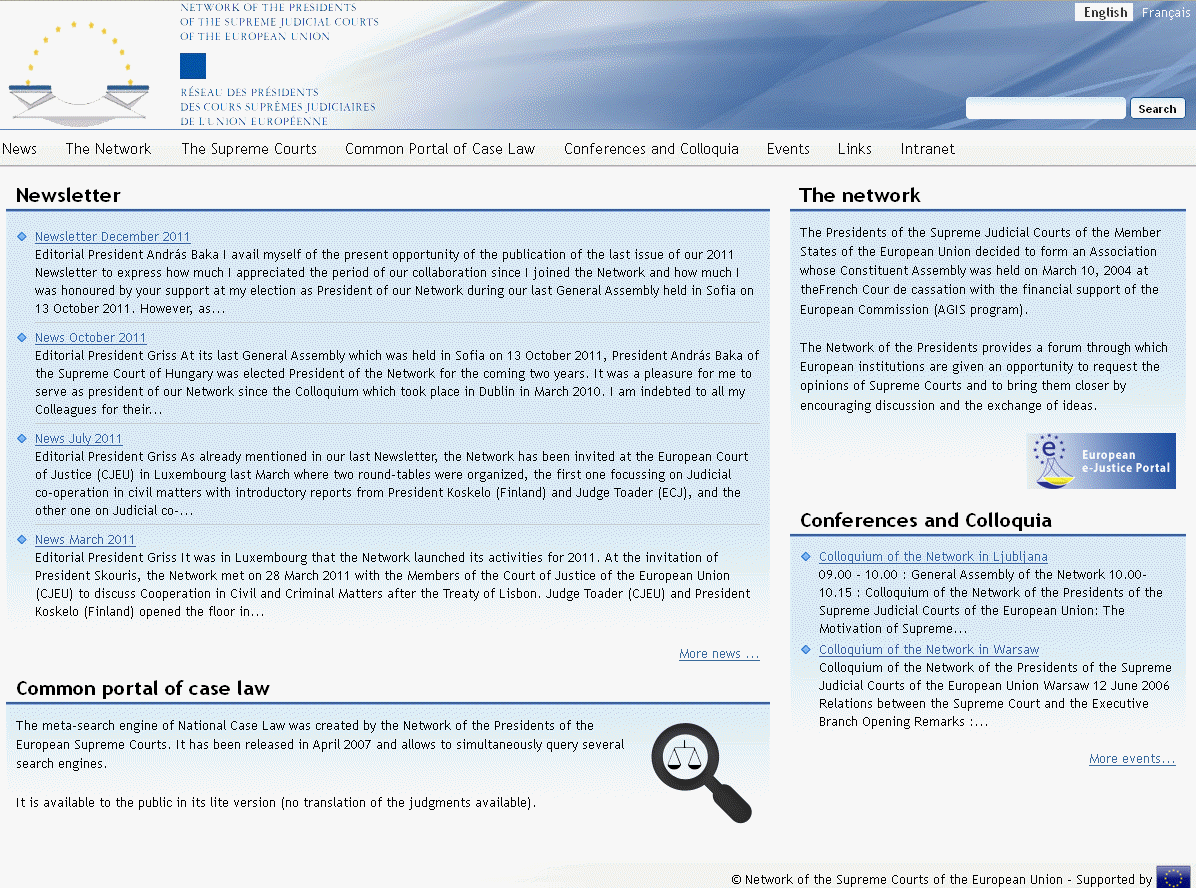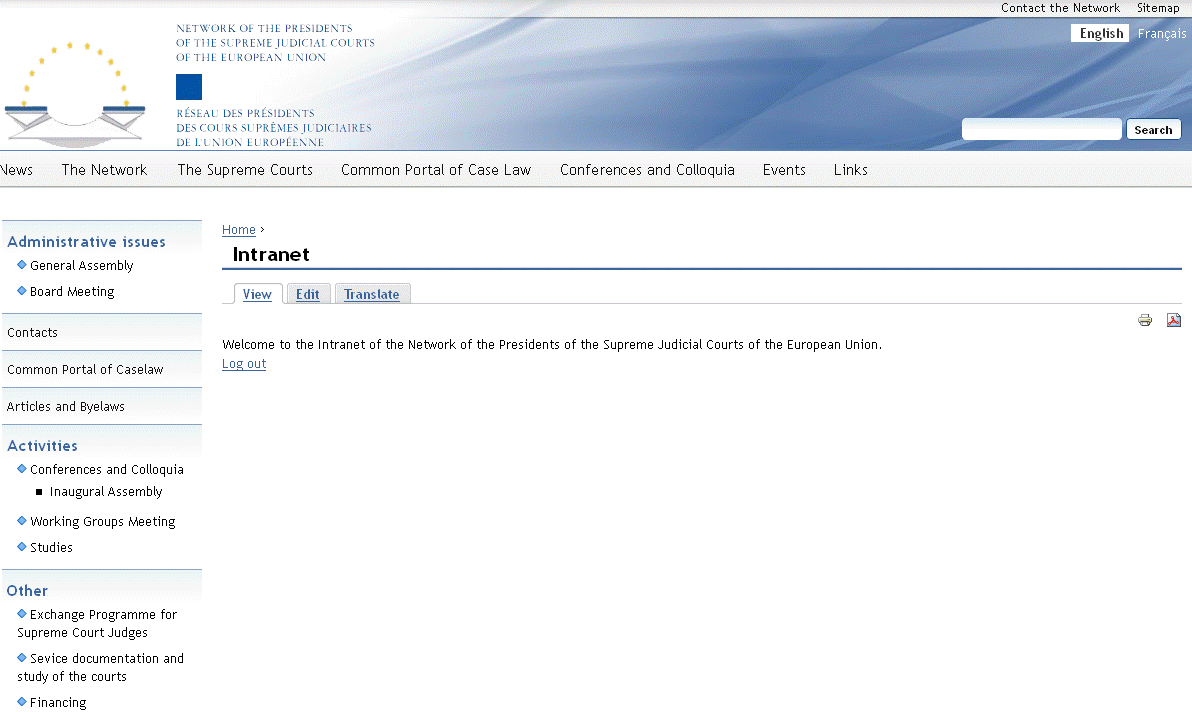Fifth Colloquium (Paris, October 2012)
The Common Portal of Jurisprudence
New Network Website
Editorial

President Geert J.M. Corstens
Following legislative changes in Hungary, President András Baka, who was elected President of our Network during the meeting of General Assembly held in Sofia in October 2011, was forced to step down as President of the Supreme Court of Hungary as of 1 January 2012, which led to the end of his term as president of the Network. On his proposal and that of the Members of the Board, Members of our Network have appointed me to preside over our activities for the next two years. I measure the magnitude of the task that I can only carry out with your support. Under the presidencies of Presidents Griss and Baka, we have already started planning our next Colloquium of 25 and 26 October 2012 on the themes of the appointment of judges to the Supreme Court, the Court of Justice of the European Union and the European Court of Human Rights. You will find in this Newsletter the preparatory questionnaire. Readers will also find information on the Common Portal of Case Law and the new Website of the Network which will be a new communication tool for its Members.
Fifth Colloquium (Paris, October 2012)
Preparatory Questionnaire
I. - Appointment of judges to the Supreme Court
1) Are open positions to judgeships at the Supreme Court publicized?
2) Who can apply to judgeships at the Supreme Court (is there a ratio for candidates not already members of the judiciary)?
3) How is conducted the selection of the Applicants to Supreme Court positions: which body is practically in charge of drawing up the list of candidates? What are the criteria for nomination on the list of candidates (age, seniority, qualifications, etc.)? Are those criteria publicized? Is there a hearing of the selected candidates? By whom?
4) Is the Supreme Court (through a specific body of the Supreme Court or in conjunction with other bodies?), and especially its President, involved in the selection process of Applicants? And in the appointment process of those who are selected (proposal, recommendation, requirement of approval, etc.)?
5) Which State bodies (other than Councils for the Judiciary and Supreme Courts) are involved in the selection and appointment process of Supreme Court judges?
6) Is there transparency of the selection process (number of applicants, selection criteria…)? And of the appointment process (publicity of the list candidates, public hearing, etc.)?
7) Who reaches the decision to appoint among the selected candidates? On which criteria (merit, representativeness of the society, professional experience, etc.)
8) Can the selection of an Applicant at the Supreme Court be appealed? By whom? To whom? And regarding the decision to appoint the selected candidate?
9) Who carries out the appointment (Head of State…)? May the appointing authority refuse to appoint?
10) Are you satisfied of the prevailing conditions in your country? Which modifications would you suggest?
II. - Appointment of judges to the Court of Justice of the European Union and to the European Court of Human Rights
1) Given the requirements of the Conventions (Article 19 of the Treaty on European Union – Article 21 of the European Convention on Human Rights and paragraph 4 of Resolution 1646 (2009)), what are the other qualifications for the candidates (independence and impartiality, professional experience, legal training, linguistic abilities, ability to work in an international environment, etc.)?
2) How is selection of the candidates conducted on national level?
3) What is the transparency of the selection / appointment process?
4) What is and should be the role of the Governments? Should a non-Government supported application be taken into consideration?
5) Are the Presidents of the Supreme Courts consulted or otherwise involved?
6) Is the European Courts or their Members involved in the process (officially / unofficially)?
7) How could the Network be of help to the Committee set up under Article 255 of the Lisbon Treaty for nominations at the Court of Justice of the European Union and to the Sub-committee set-up by the Parliamentary Assembly of the Council of Europe for nominations to the European Court of Human Rights (approval of the proposals, etc.)?
The Common Portal of Jurisprudence
The Common Portal of Jurisprudence (http://network-presidents.eu/rpcsjue) was launched in June 2006 with the backing of the European Commission and is monitored by the European Council’s “e-Law” and “e-Justice” working groups.
The Common Portal is a meta search engine which permits parallel searches using the search engines of the jurisprudence databases of the European supreme judicial courts.
This facility is provided for the private use of the EU supreme courts, the European Commission and the European Court of Justice (using an identifier and a password) and gives access to all the available databases and online translation tools.
The Portal is also open to the public, but with restricted access, confined to the free jurisprudence databases and excluding the translation of the content of decisions rendered by the supreme courts.
The databases of the supreme courts of the following countries may be consulted: Austria, Belgium, Cyprus, Croatia, Czech Republic, Estonia, Finland, France, Germany, Hungary, Italy, Liechtenstein, Lithuania, Luxembourg, Malta, Netherlands, Portugal, Romania, Slovakia, Slovenia, Sweden and United Kingdom. The databases of the Conseils d’Etat of Belgium and Netherlands are also available following a cooperation agreement with the ACA.
Once adopted, the ECLI system of identifiers will enable the Portal to operate at full capacity. At present, the problems surrounding the interrogation of the digitised supreme court databases largely stem from the lack of harmonisation between the indexation systems of the different legal terms in the various countries. Indeed, how questions are framed is dealt with differently by each database. This situation means that the Network’s computing officer (amelie.bidarddelanoe@rpcsjue.org), working together with the computing officers of each court concerned, has to ascertain the various different methods of interrogation in order to adapt the Portal to the national search engines.
Another operational problem of the Portal stems from the periodic changes made by the supreme courts to their databases, meaning that they can no longer be consulted by the Portal until re-indexing has been completed. Maintaining the Portal therefore requires constant IT vigilance and the IT officials of the supreme courts are regularly asked to indicate the changes made in their databases to the Network’s computing officer so that the Portal can be modified accordingly.
During the first three months of 2012 for instance, numerous adjustments were required in order to adapt the Portal to the changes made in the national databases of Cyprus, Croatia, Italy and Sweden.
The different technical conditions governing the operation of the search engines of the jurisprudence databases of each supreme court are also a source of problems. A major computing effort will be required to get round these differences and integrate these search engines into the Portal. The Portal’s response time is explained by the fact that, in computing terms, searches are slowed down by the complexity of the computer codes which have had to be created in order to adapt the different national search engines.
Owing to the absence of a translation database covering all EU languages, several databases have had to be used in turn. The translation tools used are the IATE database and EUROVOC translation software. Searches can be made in 20 languages: Czech, Danish, Dutch, English, Estonian, Finnish, French, German, Greek, Hungarian, Italian, Lithuanian, Norwegian, Portuguese, Romanian, Serbo-Croat, Slovak, Slovenian, Spanish and Swedish.
However, since the automated translation system of the DGT (Directorate-General for Translation) was no longer available after 16 December 2010, the Network used the free Google translation database until October 2011. In March 2012, the pay-for version of Google’s translation database was incorporated into the Portal, which has made it possible to restore the translation of the content of judgments and improve the quality of the translation of key words.
Since 2009, with the backing of the European Council, an annual meeting has been arranged of supreme court research department officials in order to familiarise them with using the Portal. A discussion list open to them has been drawn up.

New Network Website
Thanks to a European Commission grant, the Network’s website (http://network-presidents.eu/) has recently been completely redesigned. This task was carried out by the Luxembourg company AHRS Developments, which modelled itself on the layout of the e-Justice Portal, where the Network’s website is listed.
The website provides public access to information on the composition and activities of the Network, as well as giving links to the national websites of the various supreme courts.
At its next meeting in May in The Hague, the Board will consider ways and means of developing the website’s Intranet with a view to improving the Network’s internal communication. An informative website with a wealth of perhaps interactive content, including a forum or discussion area, would help to optimise contacts and broaden knowledge of the different legal systems. At present, Members can access the preparatory documents and verbatim records of the Network’s meetings, which will gradually be placed on the site.

